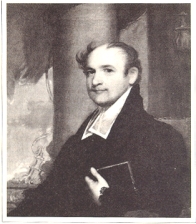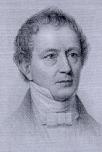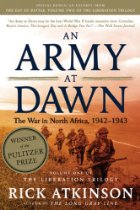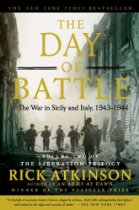Archive for the ‘Pulitzer Prize’ Category
Acquisition: An Army At Dawn: The War in North Africa, 1942 – 1943 Plus…
Just a note that I’ve picked up a copy of An Army at Dawn: The War in North Africa, 1942-1943 by Rick Atkinson. This book, the first in his Liberation Trilogy, won the Pulitzer Prize. I was quite impressed by Mr. Atkinson’s book, Crusade: The Untold Story of the Persian Gulf War, which I reviewed here.
Paperback: 768 pages
Publisher: Holt Paperbacks; Revised edition (May 15, 2007)
Language: English
ISBN-10: 0805087249
ISBN-13: 978-0805087246
I also purchased the second book in the trilogy, The Day of Battle: The War in Sicily and Italy, 1943-1944, which many reviewers have indicated surpasses the first.
Paperback: 848 pages
Publisher: Holt Paperbacks; Reprint edition (September 16, 2008)
Language: English
ISBN-10: 080508861X
ISBN-13: 978-0805088618
Even better, I’ve discovered that most of Mr. Atkinson’s books are available in audio format free from my local public library and so they will be on my MP3. Sweet!
Crusade: The Untold Story of the Persian Gulf War
Rick Atkinson. Crusade: The Untold Story of the Persian Gulf War. Houghton Mifflin Company, 1994. See the publisher’s book site here.

Pulitzer Prize winning author Rick Atkinson presents as narrative history the Persian Gulf War from its opening salvo to the American victory parade in the nation’s capital. His stated purpose is to tell the story of this “limited war,” certainly, but in doing so, he reveals much about America’s military elite and their need to heal from the failures of Vietnam. He exposes a heightened intra-service competition not unexpected in a campaign of this size but indicative of the growing role of air power in limited war. He also presents a study in leade rship and a particularly frank examination of the Schwarzkopf war room which most senior commanders feared entering due their leader’s explosive temperament and demoralizing criticism. It is Atkinson’s view that his leadership style actually prevented, to a significant degree, decentralization of initiative conducive to effective field command. The book demonstrates well that the America of the 1990’s had reached the level of superpower. Equally revealing is the jockeying for power among Schwarzkopf’s commanders. Atkinson makes a clear case for the lopsidedness of the war evidenced by an American technological and logistical strength unparalleled in history. He also emphasizes the advantages enjoyed by America’s dominance of the air and the crucial role that played in the conflict’s outcome. But he concludes that the American and allied war machine was not flawless. Weapons technology proved in some cases finicky, airplanes vulnerable to Iraqi anti-aircraft batteries, and friendly fire mishaps unavoidable.
rship and a particularly frank examination of the Schwarzkopf war room which most senior commanders feared entering due their leader’s explosive temperament and demoralizing criticism. It is Atkinson’s view that his leadership style actually prevented, to a significant degree, decentralization of initiative conducive to effective field command. The book demonstrates well that the America of the 1990’s had reached the level of superpower. Equally revealing is the jockeying for power among Schwarzkopf’s commanders. Atkinson makes a clear case for the lopsidedness of the war evidenced by an American technological and logistical strength unparalleled in history. He also emphasizes the advantages enjoyed by America’s dominance of the air and the crucial role that played in the conflict’s outcome. But he concludes that the American and allied war machine was not flawless. Weapons technology proved in some cases finicky, airplanes vulnerable to Iraqi anti-aircraft batteries, and friendly fire mishaps unavoidable.
Mr. Atkinson comes to the task of authorship with impressive credentials. A graduate of East Carolina University and the University of Chicago, his most impressive qualifications come from a strong record of investigative and writing skills. His role as primary correspondent for the Washington Post during the Gulf conflict certainly put him in the thick of that which could be revealed during the war. More extraordinary is his thorough post-conflict research including extensive interviews and the study of documents made public after the war. At the time of the book’s publication, Atkinson had already won a Pulitzer Prize (for national reporting, 1982). He would go on to win two more, one for Public Service (1999) and a third, the 2003 Pulitzer for History, for his book “An Army at Dawn: The War in North Africa, 1942-1943.” He would also serve as the 2004 General Omar N. Bradley Chair in Strategic Leadership at the Army War College, and has been a recipient of numerous journalism awards.
Crusade carries importance for a wide audience within the United States military, military historians, and civilian government. But it is particularly informative for the American public. Atkinson pulls from the shadows information about the inner workings of the American political and military engines that drove both strategy and execution of the Gulf War in a manner decidedly more guarded than the Iraq War of the 21st century. The insight allows the reader to make a more balanced evaluation of the conflict. Atkinson demonstrates the fickleness of public opinion in a powerful epilogue which contrasts the military victory parade in Washington with the demise of the Bush administration, even after what was initially considered a successful war. I find it difficult to attribute this, and other conclusions Atkinson draws, as evidence of any bias. Indisputably, the power and relevance of the book has grown immeasurably given Bush-the-younger’s return to Iraq post 911.
Highly recommend.
Next Class: Antebellum America: Prelude to Civil War
After a short break, I’ll be diving into my next class which starts November 3rd. As is my custom, I’ve added this to “The Courses” page.
“Antebellum America: Prelude to Civil War” (starts November 3rd)
This course is an analysis of the conditions existing in the United States in the first half of the 19th century. The course focuses on the political, cultural/social, economic, security, leadership, and other issues that played roles in starting and shaping the Civil War. We will analyze the issues in the context of war and peace to determine whether or not such conflicts as civil wars can be avoided prior to their inception.
Required Texts:
TBD once the syllabus is available. For now, the list is as follows which is very light in comparison with my last class:
 Publisher: W. W. Norton and Company
Publisher: W. W. Norton and CompanyHalf Slave and Half Free : The Roots of Civil War by Bruce Levine
Road to Disunion : Secessionists at Bay, 1776-1854, Volume 1 by William W. Freehling
May Civil War and Military History Book Acquisitions – II
Continuing with my May book acquisitions which illustrate, as said by Civil War Interactive’s comments on my blog this week, why bank robbery may be needed to support my book-buying habits…
This looks like a great read. Author Tom Wheeler, an accomplished man by any measure, has a terrific website here with more about his book and research. This has moved to the top of my list of reading for between terms.
I have DISCOVERED Dr. Hess and the growing list of terrific titles he has published on the Civil War. No doubt his other books will show up in my library before long. Dr. Hess, who has impressive academic credentials, has a website here. His book, Pickett’s Charge: The Last Attack at Gettysburg, was nominated for a Pulitzer Prize.
I’ve been intending to pick this up. Authored by military history professor and fellow blogger Mark Grimsley, it too is at the top of my reading list. Dr. Grimsley’s OSU webpage is here. His blog is here.
My post, “Fabian Strategy and the American Civil War” here, lead me to this book. One of my readers recommended it and suggests that it proves that the Confederacy could not have used the Fabian strategy effectively. I’m looking forward to this one.
Jav Luvaas is another prolific writer of military history and my collection of his books is growing. I first discovered his work while taking the course, Great Military Philosopers (see “The Courses” page here for details. I picked up his titles: Napoleon on the Art of War and Frederick the Great on the Art of War.
I’ll be adding these authors to my “The Historians” page shortly.
Book Report: George Bancroft
I realize this won’t be for everyone but I wanted to post the academic book review I finished yesterday on the paperback version of Russel Blaine Nye’s 1945 Pulitzer Prize winning biography George Bancroft: Brahmin Rebel. Sadly this book is out-of-print and available only via library or used book markets. It is a fascinating work filled with insights into an uncommon man who was once this country’s most revered historian – but whom most of us have no memory. It also provides considerable information about our country – and indeed the world – in the period leading up to, during and after the Civil War.
It was enlightening to put this post together in that I discovered some great sources of information about many of the people, places and times in which Bancroft lived. Kudos to http://www.harvardsquarelibrary.org for their information on important persons in that university’s history.
By Russel B. Nye. New York
(Washington Square Press, Inc.). Pp. 212. 1964. $.60
If biographies written in the twenty-first century tend toward tomes, Russel Nye’s work on George Bancroft, easily the most acclaimed American historian of the nineteenth century, demonstrates how to impress with a modicum of words. Bancroft’s life spanned a period of epic change in the fledgling American nation. Nye skillfully paints a portrait of the man against the sweeping landscape of the United State’s passage from fledgling country at the turn of 18thcentury to a battle-scarred nation ninety years later. Bancroft helped to make American history as politician and statesman. He also became one of the country’s most gifted historiographers and the first popular historian, a title that was, by the end of the century, not unlike his literary writing style, considered “passé.”
George Bancroft came from a legacy of northeastern conservatism. Bred squarely into the center of the American Calvinistic farming culture of Worcester, Massachusetts, his grandfather Samuel Bancroft was both strict Calvinist and independent of mind. Bancroft’s father, Aaron Bancroft, had a noteworthy career as one of the first leaders of the Unitarian movement. This step toward liberalism directed him to the pastorship of a small Second Congregational Church of Worcester and modest means to support his growing family. But it also positioned him with the intellectual elite of New England. The Bancroft home was a place where books were plenty and reading and discussion encouraged. Independent reason was also valued. Aaron Bancroft authored one of the more popular biographies of George Washington, a man who young George Bancroft would eventually count as among the most influential hero-leaders of the country.
George stood out among his siblings and opportunities were given to him to attend preparatory school at a young age even though it caused strain on his father’s finances. He excelled and passed entrance exams to Harvard College at the  age of 13. Bancroft graduated Harvard at 17 and, with the assistance of college president John Thornton Kirkland (pictured right and papers here), w
age of 13. Bancroft graduated Harvard at 17 and, with the assistance of college president John Thornton Kirkland (pictured right and papers here), w as provided both financial support and the necessary letters of introduction to follow a select few Harvard graduates to Göttingen, one of the top universities in Germany (brief history of the town and university here). His goal was to follow his father into the ministry. He began a rigorous course of study including a self-imposed schedule of sixteen hour days. By the age of twenty, Bancroft had a Göttingen doctorate and the respect of some of Germany’s most noted professors. But he had also developed a considerable interest in philosophy, history and literature and began to doubt whether a career in the ministry remained his passion. He continued with post doctorate studies in Berlin and by the end of his four years in Europe had met many of its influential writers, artists and academics. Bancroft returned home filled with ideas about educational reform and exhibiting mannerisms and dress inspired by his time abroad.
as provided both financial support and the necessary letters of introduction to follow a select few Harvard graduates to Göttingen, one of the top universities in Germany (brief history of the town and university here). His goal was to follow his father into the ministry. He began a rigorous course of study including a self-imposed schedule of sixteen hour days. By the age of twenty, Bancroft had a Göttingen doctorate and the respect of some of Germany’s most noted professors. But he had also developed a considerable interest in philosophy, history and literature and began to doubt whether a career in the ministry remained his passion. He continued with post doctorate studies in Berlin and by the end of his four years in Europe had met many of its influential writers, artists and academics. Bancroft returned home filled with ideas about educational reform and exhibiting mannerisms and dress inspired by his time abroad.
Bancroft spent the next several years trying to find his calling. Trained in philology (the study of languages) as well as theology, he tried on the role of Greek tutor at Harvard but became frustrated with the college’s lack of interest in adopting the new educational techniques he brought from abroad. He was also unpopular as a teacher, which is not to say that he was a bad teacher; rather a demanding one. By mutual consent, he left Harvard after a year and with fellow Harvard and Göttingen graduate Joseph Cogswell, opened the Round Hill School for boys near Northampton, Massachusetts in 1823. It became a phenomenon of sorts due to the melding of the latest methods of European educational reform with those of American boarding school. “It was one of the earliest and most successful efforts of the nineteenth century to raise the level of American secondary education by absorbing the new European experimentation, and served as a powerful influence in the diffusion of new ideas on discipline, individual attention, and stimulation of student interest” (45). A student was treated as an individual with unique learning patterns and cooperated as an equal with his teacher rather than as an inferior with his master. Despite the demanding program, the elite of New England clamored to enroll their sons. With Bancroft as the primary teacher and Cogswell managing administration, the school grew in both size and reputation.
It was at Round Hill School that Bancroft met his wife, Sarah Dwight. Her status as the daughter of a wealthy New England family would ensure his financial independence. Bancroft also continued to work on his poetry (he had published Poems while at Harvard) and found opportunity for preaching. But he was successful at neither. His poetry was labeled amateurish and his oration at the pulpit “too consciously learned, too pretentiously oratorical” (5). Interestingly, Bancroft would become a gifted literary critic. A man of many interests, he became bored with the life of a country school teacher and bowed out of the venture in 1831. The Round Hill School failed three years later.
Bancroft discovered while at Round Hill a growing interest in politics. He began to write for prominent journals and even spoke in a political forum in Northampton at the behest of town leaders. In 1830 he was nominated for the Massachusetts’s senate by the Workingmen’s party. Although he declined, his voice as a political philosopher began to emerge. It was firmly centered on the premise that the will of the many outweighed that of the few, a principle that he considered foundational to democracy. He clearly identified himself as a Jacksonian democrat in 1836, a fact that surprised a number of his Whig Harvard colleague s including friend Edward Everett (pictured right). His allegiance was with the common, agrarian masses rather than the privileged minority. His political position became all the more public with Bancroft’s growing involvement in the Democratic Party. He wrote several journal articles in support of Jackson’s position on the national banking issue which he attributed to the long struggle between capitalists and laborers. In 1838, his party work was rewarded with the position of Collector of the Port of Boston. By 1844, he was a prominent player in the Massachusetts democratic delegation and played a key role in securing the Presidential nomination for
s including friend Edward Everett (pictured right). His allegiance was with the common, agrarian masses rather than the privileged minority. His political position became all the more public with Bancroft’s growing involvement in the Democratic Party. He wrote several journal articles in support of Jackson’s position on the national banking issue which he attributed to the long struggle between capitalists and laborers. In 1838, his party work was rewarded with the position of Collector of the Port of Boston. By 1844, he was a prominent player in the Massachusetts democratic delegation and played a key role in securing the Presidential nomination for  James K. Polk (pictured left). Polk appointed Bancroft Secretary of the Navy the following year and he found himself Acting Secretary of War during the months that opened the Mexican War. But Bancroft was after a diplomatic post and between 1846 and 1849 he served as United States Minister to England. It was during this time that he amassed a huge collection of historical notes from British archives, utilizing scribes and secretaries to copy copious amounts of data. These he brought home to America for use in future historical writing.
James K. Polk (pictured left). Polk appointed Bancroft Secretary of the Navy the following year and he found himself Acting Secretary of War during the months that opened the Mexican War. But Bancroft was after a diplomatic post and between 1846 and 1849 he served as United States Minister to England. It was during this time that he amassed a huge collection of historical notes from British archives, utilizing scribes and secretaries to copy copious amounts of data. These he brought home to America for use in future historical writing.
The scholar in Bancroft had found new voice shortly after leaving Round Hill. In 1834, he published the first of what would become his multi-volume treatise, A History of the United States from the Discovery of the Continent (set of all volumes to right). (A full listing of Bancroft’s works avail able online can be found here.) He chose to focus not on contemporary history but rather on the formation and evolution of the nation. Bancroft believed that the creation of the United States of America was part of a divine plan. It was a demonstration for all the world of the efficacy of a nation built on the principles of liberty.
able online can be found here.) He chose to focus not on contemporary history but rather on the formation and evolution of the nation. Bancroft believed that the creation of the United States of America was part of a divine plan. It was a demonstration for all the world of the efficacy of a nation built on the principles of liberty.
Pivotal to the country’s success was the quality of its leaders. “The secret of the science of governing, Bancroft decided, lay in the quality of a nation’s leaders – those great men who personify the people’s ideals, act out their interests, and crystallize their needs in laws and institutions” (82). Nye found that Bancroft valued two types of hero-leaders. The first was the agrarian nobleman best exemplified in Andrew Jackson (pictured below).

His gift was an innate perceptiveness gained from long connection with nature. The second was the classic wise man whose traits Bancroft found in George Washington, a man for whom he had a lifelong admiration.
Abraham Lincoln eventually became Bancroft’s third hero-leader. While initially unimpressed with Lincoln, his respect for him grew to such a degree that he eventually thought him representative of the genius of the American people. Bancroft’s regard for Lincoln was no doubt one reason that he was chosen by Congress to deliver his eulogy. It was considered his best oration.

Like the nation, Bancroft had to come to terms with slavery. He blamed the English for its introduction to the colonies and thought it a temporary evil gone array. Its conflict with the principles of liberty was always obvious. While never a flaming abolitionist, Bancroft considered slavery the primary cause of the Civil War and spoke out about it primarily in his writing. He was a resolute unionist and had little sympathy for arguments for state rights and for the succession movement.
Bancroft happily finished his diplomatic career in Germany where he became a favorite of politicians and intellectuals. He returned to a quite life, still writing and active for most of his ninety-one years. The portrait below was painted while Bancroft was in diplomatic residence in Germany.
Nye does a masterful job of identifying Bancroft’s core beliefs and the influences that formed the man and his career. He also shows a considerable grasp of the nuances of history that were in play in the 19th century, worth noting because Nye’s training is in literature rather than history. His obvious mastery of the large collection of papers Bancroft left behind for his biographers is impressive.
Nye leaves the reader with a sense for the utter brilliance of Bancroft (pictured below in his study) and yet presents him as anything but infallible. He was a man who enjoyed the privileges of an education well beyond the norm of his day and earned by an innate drive and love for scholarship. He was comfortable with life choices that went ag ainst the norm, an indication of independence of thought. He was not unfamiliar with loss, having endured the death of his young wife. He knew failure, having disappointed those who saw in him potential as minister. His failure as a poet, a personal aspiration, revealed a level of sensitivity (He worked very hard to find and destroy every copy of his Poems.). He embraced cultures and perspectives outside of his own and yet remained an American patriot. He brought to his generation a better sense of the story of their country and to a large degree, popularized history. He remained a loud voice for the ideals of liberty and democracy and the rights and privileges of the masses. But at his core, he was, as depicted by Nye, a man of letters and I suspect that Mr. Bancroft would be pleased with that distinction. His legacy is a remarkable body of work sadly forgotten by most citizens of the 21st century.
ainst the norm, an indication of independence of thought. He was not unfamiliar with loss, having endured the death of his young wife. He knew failure, having disappointed those who saw in him potential as minister. His failure as a poet, a personal aspiration, revealed a level of sensitivity (He worked very hard to find and destroy every copy of his Poems.). He embraced cultures and perspectives outside of his own and yet remained an American patriot. He brought to his generation a better sense of the story of their country and to a large degree, popularized history. He remained a loud voice for the ideals of liberty and democracy and the rights and privileges of the masses. But at his core, he was, as depicted by Nye, a man of letters and I suspect that Mr. Bancroft would be pleased with that distinction. His legacy is a remarkable body of work sadly forgotten by most citizens of the 21st century.
American Military University
Rene Tyree






























































